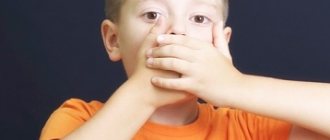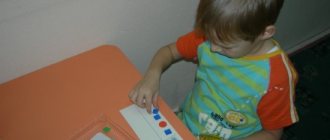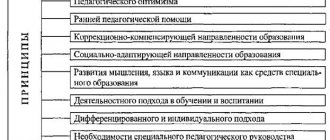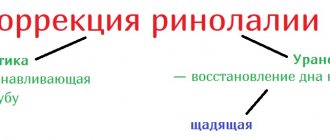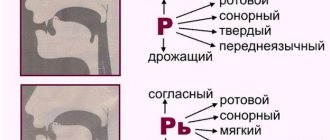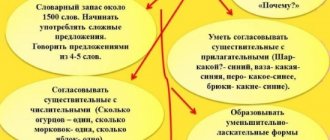Dyslexia is a speech disorder characterized by a persistent selective inability to master reading while maintaining intelligence and hearing.
The main problem is the inability to master letters, the ability to read syllables, words, sentences and texts. Often misreading words leads to misunderstanding of the meaning
These problems create serious obstacles to a child’s schooling, since solving problems and completing test tasks requires the ability to read correctly and quickly. Reading disorders arise due to the immaturity of the higher mental functions involved in this process.
Reading disorders are eliminated by a specific specialist - a speech therapist. Let's consider what dyslexia is in children, what types and signs of this speech disorder can be identified independently.
Symptoms of dyslexia
The symptoms of the disorder consist of manifestations that are directly related to the reading disorder. It also includes a complex of disorders of sensorimotor and cognitive functions, which are the basis of the psychological aspects of difficulties in the reading process.
Characteristic manifestations of dyslexia are the following:
- Failure to assimilate letters, an inaccurate relationship of sounds with their graphic images, manifested in replacements or mixtures (several replacements) of phonemes when reading (p-t, ts-s, t, a-o, i, e, i).
- Letter-by-letter reading is the incorrect combination of letters into syllables or words. The letters are simply listed sequentially.
- Errors in reproducing the sound-syllable structure of a word.
- Incorrect reading comprehension at the level of a single word, sentence, or text.
- Agrammatisms. The most popular errors are the agreement of a noun with an adjective, verb (for example, a beautiful book, the sun rose, the children were walking), violation of case endings (on the trees) and others.
To check a child for this speech disorder, it is enough to undergo a speech therapy examination, which is very similar to testing. Any good speech therapist can do it.
Dysgraphia (persistent and specific spelling errors in writing) is often diagnosed along with dyslexia, although these problems can arise in some cases in isolation from each other.
There is an opinion that dyslexia is a mental illness. It is fundamentally incorrect, as is the term treatment of dyslexia. From a psychological point of view, with dyslexia, the mental functions necessary for the reading process are impaired or partially underdeveloped.
In the process of reading, children quickly get tired and have difficulty perceiving what they read aurally. The psycho-emotional state of a dyslexic is depressed due to awareness of his defect.
A violation of fine and gross motor skills may be diagnosed; the child is poorly oriented in space and on a sheet of paper. If dyslexia is not associated with mental fatigue, it can be diagnosed against the background of a sufficient or high level of intellectual development in children.
Articulation gymnastics
You should start your classes with warm-up exercises:
- inhale through the nose and exhale through the mouth;
- inhale - hold your breath for a few seconds - exhale;
- We take an incomplete breath and do not exhale the air completely.
This is followed by exercises that develop clarity and intelligibility of pronunciation. The child is asked to complete phrases with associative sounds:
- a fly flies around the room “z-z-z”;
- the dog growls at the cat “rrrr”;
- a snake crawls in the grass “sh-sh-sh”;
- a bumblebee lands on a flower “w-w-w”;
- a horse runs across the field “clack-clack-clack”, etc.
Take a deep breath and, on one exhale, read all the consonants in the line:
- KNSHLZZTSSBTMPVCHF;
- VMRGKTBDZSHCHZBCHVN;
- VDGBFKZRChPTKZRM;
- ChMKPBRVSFSHMZHDSHH.
Read the phrases slowly and clearly:
- ru-ru-ru - the keguru ran away;
- you-you-you - the cats meowed;
- chi-chi-chi - all the balls rolled.
Read in a whisper at a moderate pace:
- arna – arla;
- arzha – arch;
- arla – arma;
- arba - harp.
Read out loud and as quickly as possible:
- burn – oven – lie down;
- door – worm – beast;
- chalk - stake - silt;
- fry - steam - burn.
Read aloud tongue twisters, sayings and proverbs:
- as is the fiber, so is the linen;
- whether they watered the lily, whether they saw Lydia;
- the ships tacked, tacked, but did not tack;
- Geese cackle on the mountain, a fire burns under the mountain;
- our duda is both here and there.
Causes of dyslexia
The causes of dyslexia are varied - they can be organic, functional, biological, social. The history of children with this speech disorder includes many factors that influence throughout different periods of the child’s development.
Dyslexic disorders are often caused by organic damage to the speech centers of the cerebral cortex involved in organizing reading, delays in the maturation of these areas of the brain, and their improper functioning. Reading difficulties are often caused by long-term somatic illnesses in young children.
Causes of dysgraphia in a child and methods of its correction
A special place in the appearance of the disorder is occupied by social factors that create an unfavorable background that provokes the emergence of problems. This includes incorrect speech of loved ones, bilingualism (bilingualism), insufficient attention of parents to the speech development of children, limited, poor communication with the child, and an unfavorable situation in the family.
If a child has oral speech pathologies (FFN, OSR), it is more likely that he will suffer from dyslexia and dysgraphia.
In complex cases, dyslexic disorders may appear as part of a severe complex disorder. For example, with mental retardation, mental retardation, minimal brain dysfunction, in persons with visual or auditory defects, cerebral palsy.
Essentially, there are two global causes of dyslexia: congenital and acquired. According to research by specialists, heredity plays a large role in its appearance - yes, dyslexia is inherited.
Common etiologies of dyslexia:
- Minimal brain dysfunction;
- Fetal hypoxia and asphyxia during childbirth;
- Premature placental abruption;
- Jaundice in newborns;
- Hemolytic disease of the fetus;
- Toxic effects on the fetus of alcohol, nicotine and medications;
- Infectious diseases suffered by the child or mother during pregnancy (influenza, measles, rubella, chicken pox, herpes, polio), neuroinfections;
- Consequences of traumatic brain injury;
- Organic damage to the speech areas of the brain.
Also, the development of dyslexia can be affected by bilingualism in the family, pedagogical neglect of the child, lack of communication, thoughtless adherence by parents to early development methods, too early literacy training, or an incorrectly chosen method of reading development.
There is no such thing as dyslexia in preschoolers! To make this diagnosis, you must first try to teach the child to read, and this is done from the age of 7. It doesn't count before. If you were diagnosed with this in preschool age, you should contact another specialist. Normally, a “diagnosis of dyslexia” is appropriate by the end of the 2nd grade of primary school.
The acquired form is more common in adults, as a consequence of a stroke. People have to learn to read and write again. We will talk about it a little below.
Working on establishing correct word order
The task is aimed at improving the student’s understanding of the text he is reading. The task is to make sentences in accordance with the picture. The child needs to correctly fill in the blanks when describing the image. At the same time, it is important to ensure that the word order is correct and the sentences are constructed correctly.
The girl is riding. _______ _______ on _______. _______ _______ on _______ in_______. _______ _______ on _______ in _______ and ________.
Systematic implementation of such game exercises helps the student cope with the difficulties that arise when mastering reading skills. Dyslexics significantly improve their reading technique and quality, improve their skills in working with textual material, and also increase their self-esteem and self-confidence. At the same time, it is important to remember that only a specialist can correctly correct dyslexia, who will select the most suitable types of work and exercises for a particular form of the disease.
Publication date: 05/06/2019. Last modified: 01/13/2020.
Types of dyslexia
Speech disorders can be classified into several types. Classification according to leading manifestations:
- Verbal form – difficulties with reading words are noted.
- Literal form - there are problems with the assimilation of letters (letters).
Classification is also made according to defective mechanisms of the reading process and symptoms. There are six forms of dyslexia:
Phonemic
The processes of synthesis and analysis, and the perception of phonemes are disrupted. The disorder is characterized by letter-by-letter reading, the child replaces or mixes deaf and voiced, hissing and whistling sounds, adds, skips and rearranges sounds and syllables (instead of writing - squeaks, instead of butterfly - daddy, shovel - lotapa, duck - tuka). He can skip consonants when they come together (marka - mara), insert extra vowels where they are not provided (legla - legala).
When correcting phonemic dyslexia, a speech therapist develops all aspects of speech in the child, as well as memory, attention, and verbal thinking. A dyslexic person learns to conduct sound-letter and sound-syllable analysis of words.
Semantic
Semantic dyslexia manifests itself in unformed syllable synthesis: the child has a poor vocabulary and cannot learn syntactic connections in a sentence. Reading is “mechanical” in nature; the reader may have good reading technique, but does not understand the meaning of what he read. He does not establish any connection between words, perceiving them as a set of individual words.
The same thing happens with adding syllables into a word - the child cannot recognize the word, perceives it as a set of syllables or sounds. It occurs in children with mental retardation, mental retardation (MDD), and minimal brain dysfunction (MCD).
In the case of the semantic form of speech disorders, they fill the vocabulary of a junior schoolchild, help him master the grammar of his native language and syllabic synthesis.
Ungrammatical
The grammatical structure of speech is underdeveloped; when reading, the child makes mistakes in agreeing words by gender, case and number, retaining them in writing and in ordinary speech, incorrectly reads parts of words (suffixes, prefixes, endings), incorrectly agrees words in sentences (in stores, five woodpeckers, forest clearing, fallen leaves).
Correction of agrammatic dyslexia includes the formation of correct language norms, the ability to form and change words. With mnestic dyslexia, visual gnosis and auditory-sound memory are formed.
Mnestic
With mnestic dyslexia, speech memory is impaired; the child has difficulty relating letters and sounds to each other and does not remember them. As a result, he shifts and replaces letters when reading, reduces the number of letters in a word, and cannot reproduce 3-5 consecutively pronounced sounds or syllables.
Optical
The reader replaces or mixes letters that are similar to each other (p-d, b-d, z-v), and while reading he slips from line to line. May manifest as “mirror reading” of letters from right to left.
Tactile
Tactile dyslexia occurs in visually impaired and blind people who miss letters and syllables when reading Braille, slip from line to line, and distort the meaning of what they read when retelling. If a child suffers from the tactile type, he develops spatial orientation and tactile perception of objects and patterns.
The oral speech of children with dyslexia is often far from ideal, has many grammatical errors, defects in sound pronunciation, and contains unrelated statements and incorrectly used words.
Prognosis of dyslexia with organic brain damage - diligent corrective work is required to form missing stages of the reading process.
If dyslexia in younger schoolchildren is caused by pedagogical neglect, bilingualism, early learning to read, or a deficit in verbal communication, you can count on complete correction of the defect when the child’s parents work together with a speech therapist or psychologist.
Game "ladder"
The child is asked to read words with different numbers of syllables, which are arranged in the form of a ladder: HEDGEHOG CANCER HIS LUM HORSE GIRL PRESIDENT GEAR SILKY
In this case, the student needs to complete several tasks:
- read the words located in the “ladder” from top to bottom;
- If you come across an incomprehensible word, you should find out what it means and read it several times;
- if the word is difficult to read in its entirety, it is necessary to divide it into syllables or letters, and then combine it into one whole;
- read the “ladder” from bottom to top.
Diagnostic methods
Often, this speech disorder is recognized late: in the 3rd or 4th grade of primary school. Unfortunately, if a child confuses syllables in a word, not all teachers and parents wonder why this happens. All symptoms of a speech disorder are attributed to the child’s laziness and inattention, his lack of diligence - the problem cannot be identified immediately.
If the symptoms of dyslexia described above are detected, the child should be examined by a speech therapist, psychologist, psychoneurologist, or pediatric neurologist. It’s worth starting with a speech therapist; every specialist in this chain knows how to treat (correct) their particular area of the problem.
Diagnosis of dyslexia includes several parameters analyzed by specialists:
- anamnesis (the course of pregnancy and childbirth in the mother, previous diseases);
- academic performance in the Russian language;
- state of articulation organs;
- degree of development of fine motor skills;
- development of vocabulary, grammar, phonemics, sound pronunciation, coherent speech;
- state of written speech (copying from a sample, writing from dictation, independent writing);
- level of reading mastery (pace, correctness, method of reading, comprehension of the text, presence of typical errors);
- state of speech analysis and synthesis;
- level of development of visual recognition of letters;
- state of orientation in space.
The diagnostic examination may include a consultation with an ophthalmologist for a vision test and a neurologist for an electroencephalogram.
Memorizing graphic expressions of words
Each star has a specific syllable written on it. It is necessary to compose words and circle them with multi-colored pencils (for example, crow, textbook, carpet, alphabet, teacher, etc.).
The second version of the exercise, or the game “Treasure Island”. The child needs to get to the treasure chest by making up words from the syllables written under the small islands. The composed words should be painted in different colors (for example, jungle, islands, etc.).
In order to improve perception and supplement the associative series, you can supplement the task with cards depicting the words that the child composes.
Dyslexia in adults
Typically, dyslexia in an adult is a consequence of not receiving speech therapy in childhood. Often, it appears in adulthood when a person develops an intellectual disorder, or when the disorder affects the area of auditory perception of information. This provokes difficulties, since the signals entering the brain are distorted and processed inaccurately.
Also, problems with reading may appear as a result of trauma or psychological shock experienced. Dyslexia that occurs in an adult leads to maladjustment. Therefore, it is important to contact a speech therapist in a timely manner and receive effective help in overcoming this disorder.
Signs of dyslexia in an adult:
- Incorrect, distorted pronunciation of complex, long or unfamiliar words.
- Errors when reading graphically similar words.
- Illiterate writing, multiple grammatical errors, poor vocabulary, difficulty in writing letters, statements and other independent statements.
- Low reading speed and difficulty remembering what you read.
- Difficulties with simple arithmetic calculations. They may be signs of dyscalculia.
People with dyslexia need constant supervision from specialists. After conducting a full examination, the speech therapist develops a plan of correctional work, based on the individual characteristics of the person and the severity of the disorder.
Correction methods
In addition to the negative impact on a student’s academic performance, dyslexia negatively affects the development of his personality. Difficulties in mastering reading can provoke the emergence of such personality traits as self-doubt, shyness, anxiety, suspiciousness, isolation or aggression, irritability, negativism. Therefore, a special role belongs to the early detection and correction of this disorder.
If you consult a speech therapist when you notice the first signs of dyslexia, you can minimize its manifestations. The later the corrective work is carried out, the more time it will take to eliminate this violation.
To eliminate reading impairment, a unified system of correctional intervention is necessary, since very often dysgraphia, dyslexia, dysorthography do not exist in isolation, but most often accompany each other.
Main directions of correctional work:
- Development and improvement of phonemic perception (the ability to isolate given sounds, distinguish sounds that are similar in sound, for example: s-ts, ch-shch, r-l), not only in oral speech, but also in written speech. This work is carried out with the participation of a speech motor analyzer, therefore, simultaneously with the development of phonemic hearing, work is carried out on sound pronunciation;
- Work on sound pronunciation - eliminate deficiencies, practice articulation, form correct breathing, automate sounds in coherent statements, teach to distinguish sounds that are similar in sound;
- Development of sound analysis and synthesis skills. The main types of this work are: isolating sentences from the text, words from sentences, syllables and sounds from words, such analysis is accompanied by the compilation of various diagrams that simplify the understanding of the basic terms of the Russian language;
- In correctional work, great importance is attached to the development of mental processes: perception, attention, thinking, memory. For this purpose, various tasks and educational games are recommended. For example: “What has changed?”, “Find out by voice”, “Vegetable garden”, “Fill in the shapes with letters”, “Assemble the animal”, “Match by shape”, etc.
- Clarification of the meanings of words available to children and further enrichment of vocabulary by accumulating new words related to different parts of speech; familiarization with various methods of word formation and inflection. Development and further improvement of the grammatical design of speech based on mastering sentences of various syntactic structures: simple and complex.
- Improving coherent speech, working on the sentence as the main speech unit. We pay attention to punctuation marks, which activates the student to use correct intonation when reading. You can read the same sentence with different intonations. Read the text in different ways, for example: slowly - like a turtle, cowardly - like a bunny, melodiously - like a bird, loudly - like a bear and other types of work.
There are several methods for correcting dyslexia in schoolchildren. The most popular are the Ronald Davis method and the A.N. Korneva.
Ronald Davis method
Ronald D. Davis developed a method for eliminating dyslexia and opened the first clinic for reading problems.
The uniqueness of the method lies in the fact that it helps a dyslexic person learn to control manifestations of disorientation or lack of attention, teaches him to perceive the most difficult and complexly written symbols and words, and then translate them into images in his imagination, thereby filling in the gaps in perception.
The method is based on visual rather than verbal thinking. It contains three main stages:
- Learning to “control” the alphabet and linguistic signs, for example: by fashioning them from plasticine. When a child makes letters on his own, he touches them and imagines their image, which improves his handwriting.
- Learning to “control” abstract words, which a dyslexic has no image of.
- Formation of the skill of consistency and understanding in the reading process.
The Davis method not only teaches writing, it develops self-organization skills: it develops a sense of time, order and duration, and teaches concentration.
Methodology A.N. Korneva
It is called “Correction of persistent inability to master reading and writing” and is used to correct dyslexia in primary schoolchildren.
The technique is aimed at early detection of insufficient development of processes necessary for mastering the school curriculum and speech development of children. But these tests are often used by teachers when organizing work with dyslexics.
Dyslexia – disease or normal?
First, let's understand how the dyslexic brain works. You know that our brain consists of a left and a right hemisphere. The left is responsible for logic, language, speech, reading, numbers, consistency, rationality. And the right one is for imagination, intuition, feelings, images and spatial thinking.
Dyslexics have more activity in the right hemisphere and frontal lobe. And when reading, it is more difficult for them to focus on the letters, connect them into syllables and words, and understand the meaning of what they read.
For such children, the letters in words look like hooks and are remembered in the form of pictures. That is, in order for a dyslexic to learn a word and attach a meaning to it, he needs to remember the picture of hooks in the smallest detail. And then he guesses what might be written there. As a result, reading turns into agony and takes a lot of effort and time.
Is dyslexia normal? On the one hand, no. Because it interferes with normal development. But on the other hand, dyslexics are absolutely normal children who, outside of the learning process, are no different from their peers. Their brains just work differently.
Moreover, it is among dyslexics that there are the most geniuses and outstanding people. As proof of this, such names as Marilyn Monroe, Albert Einstein, Walt Disney, Hans Christian Anderson, Vladimir Mayakovsky, Quentin Tarantino and a number of others.
You might be thinking, “How do people with reading and writing disorders become famous writers, actors, and directors?” From a logical point of view, this is difficult to believe. But in fact, this happens because dyslexics are very good at compensating for their lack in life. They are more diligent and purposeful than ordinary people, because they want to prove to themselves and the world that they are no worse than others. And as we said, because their brain works differently.
Yes, of course, we understand that this does not make it any easier for you. After all, the child falls behind in school, is subject to ridicule from classmates and pressure from teachers. His self-esteem falls and he withdraws more and more into himself.
Therefore, the sooner you start acting, the easier it will be for your child in the future.
Exercises to correct dyslexia
Learning to write is the most difficult period of schooling. The number of schoolchildren making multiple specific mistakes is constantly increasing. Adults often associate these mistakes with absent-mindedness.
Special work to overcome dyslexia is based on performing special exercises aimed at developing all aspects of speech. In addition, exercises affect the development of fine motor skills, mental processes, and also normalize the emotional-volitional sphere. They form the rudiments for the correct development of written speech, increase the level of general development, enrich the vocabulary, and improve the sense of language.
Exercises to develop phonemic processes
Exercises train phonemic hearing, perception, and memory. They develop the ability to isolate a given phoneme from a word, determine their number in words, and the skill of selecting words with a given number of phonemes.
Differentiate oppositional voiced and voiceless, soft and hard consonant sounds. Discrimination is carried out according to the following algorithm: listen, pronounce, distinguish, write down. At the stage of pronouncing syllables, you need to connect a kinesthetic analyzer, for example: raise your hand for voiced phonemes, and lower your hand for voiceless phonemes.
Determine the sonority of sounds. After mastering the differences in the articulation of voiced and voiceless phonemes, tablets with their symbols are prepared. On one you need to draw a triangle, on the other you need to draw a circle. The child is asked to listen to the words, determine what sound they begin with, and pick up the appropriate card. After oral practice, words are written either in two columns, or only with voiceless consonants, or only with voiced consonants.
Name a word that is different from the others. Discrimination by ear of phonemes that are similar in acoustic parameters, exact repetition of all words with them.
Ball games. They are aimed at the formation of phonemic processes, general and fine motor skills, spatial orientation, regulation of purposeful movements, improvement of accuracy and dexterity. Thanks to them, attention is activated and the behavioral sphere is normalized:
- “I know a lot of words.” The child needs to pronounce several words on a specific topic or starting with a specific sound; when pronouncing each word, you can use a ball, knocking it on the floor when pronouncing.
- "Know-it-all." The adult asks a question, passing the ball to the child. The child catches the ball and answers the question with an extended phrase. All words in the answer begin with one specific sound.
- "Accountant". An adult says a word and throws a ball. The child needs to catch the ball, count the number of sounds in the word and say a word containing the same number of phonemes by throwing the ball back.
Exercises for the development of the speech apparatus and voice
Exercises that develop articulatory clarity, breathing, and voice affect the success of mastering school material. They are based on pronouncing tongue twisters, rhythmic texts, poems, imply the exact repetition of what was heard, and allow you to feel the speech rhythm and tempo.
Insufficient activity of the articulatory organs, accuracy in performing given patterns, and impaired breathing lead to learning difficulties. Work on the development of the speech apparatus contains articulatory and breathing exercises. Producing correct exhalation optimizes the functioning of the circulatory system and has a beneficial effect on the functioning of the entire body.
Smooth breathing allows you to relax and concentrate. The breathing rhythm is the only rhythm of the body that a person is able to consciously control and actively regulate. Breathing exercises can be performed at any stage of the lesson. These include playing wind musical instruments, blowing soap bubbles, and imitating natural processes: sucking, yawning, coughing.
A special place in the development of articulatory organs belongs to the work on tongue twisters. It solves many problems: improving phonemic processes, clarifying the articulatory structure of phonemes, practicing articulatory clarity, long, correct exhalation, memory development, eliminating the fear of pronouncing complex words, ensuring a positive psychological attitude. It allows you to catch speech rhythm, tempo, and helps increase the speed of both oral and written speech.
Exercises to develop fine motor skills
Exercises that develop hand motor skills can improve the emotional state, develop memory and speech. To develop fine motor skills, you can use massage, finger exercises, games, shading, modeling, and drawing. Origami is also suitable:
Exercises to improve visual perception
Performing proofreading tests is well suited for developing work on visual processes. They are necessary to correct visual attention, perception, and create a visual image of a letter.
- "Fly". In the center of the square, divided into cells, a fly is depicted. The adult dictates the path of its movement, for example, 2 cells to the right, 3 cells down, etc. First, the child moves his finger along the cells, then mentally imagines its movement. At the final stage, the child, with his eyes closed, must imagine the path and say in which cell he needs to stop.
- "Upside down". The sheet with printed text unfolds several degrees. The child must read the text without turning his head.
- “Find out from the half letter.” The upper or lower half of the line is covered with a white sheet of paper or part of the line is sealed, the child must read the sentence. This test forms a visual image of letters, the ability to quickly read one or several words at the same time.
- "Lame text." The child is asked to read sentences that are printed in two fonts. Explain their meaning. Note the specifics of writing. Read what is shown in printed font and what is in italics. Copy words printed in the same font. Read the resulting sentence.
Additional exercises
In order for the learning process to go faster, it is important to further develop the speech, memory, attention and thinking of a preschooler (or primary school student). To do this, you can use the following exercise games:
- When going to the store, make a shopping list with your son (daughter), draw on paper a diagram of the movement along the street and the store. On the way (if you are walking) ask - where should you go? Ask to show the way, indicate landmarks.
- It is very useful to play regular hopscotch or “soldiers” with your child so that he will make turns on command - to the right, to the left.
- Hide a toy (or other thing) in your apartment and draw a diagram where you can find it. Ask your child to do this.
- Select 7-10 toys and place them in a row. Then invite the child to enter the room, let him look at the toys for 5 seconds, ask him to turn away. Hide one toy, ask to determine which one was hidden.
- Place 5-10 small toys (or objects with a pronounced texture) into a bag. Let the child study them first, and then, putting the pen into the bag, determine by touch what exactly is in his hand.
- In the evening, while communicating, ask you to remember sequentially what the baby did in the morning, afternoon, and evening. What worked for him, what didn’t. Discuss the plan for the next day.

